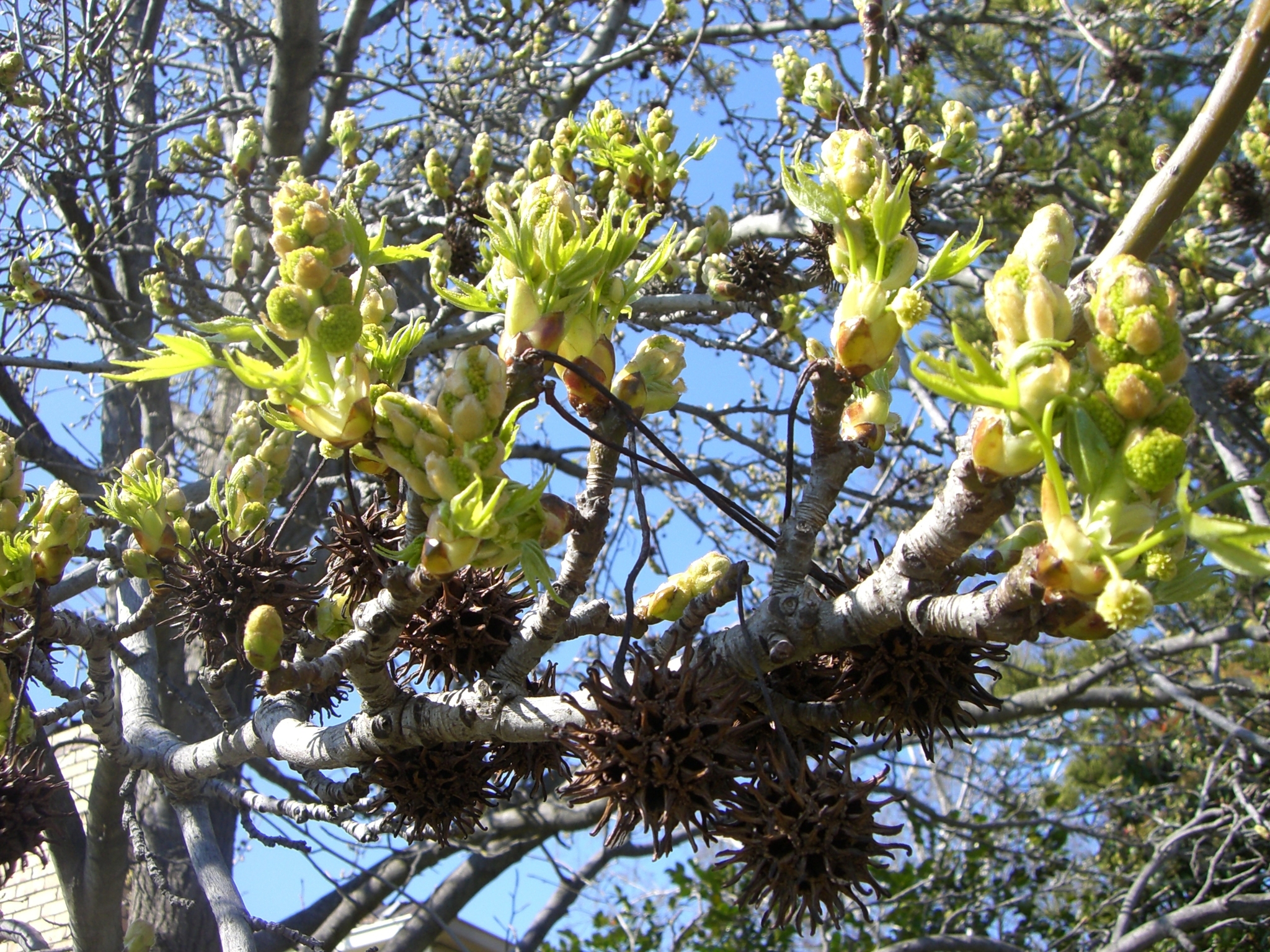
Large deciduous, conical tree to 30 m or more tall. Branchlets with unusual corky outgrowths along the length. Leaves about 15-20 cm wide, palmate with 5(-7) lobes, finely toothed with tufts of hair in the vein axils; colouring various shades of red, yellow, orange, burgundy and purple in autumn. Leaf stalk 8-15 cm long. Flowers inconspicuous, in roundish, red clusters at the tips of new shoots; early spring. Fruit a spiky ball of capsules.
SE North America
Grows naturally in moist areas, valleys and along the coast of SE USA. Extremely variable in autumn colouring both in different areas and on different trees. The depth of leaf lobing is also variable, some trees having lobes cut almost to the leaf stalk.
A range of autumnal colour cultivars may be encountered with variegations of green, white, gold, orange, red and purplish burgundy. Golden cultivars include 'Aurea' and 'Moon Beam'; 'Canberra Gem' has apricot colourings; deep reds include ‘Aurora’ and ‘Burgundy’ while the leaves of ‘Variegata’ are marbled green and white (originating from Europe in the 19th century). Multicolours occur in ‘Kia’, ‘Palo Alto’ (raised at Saratoga Horticultural Foundation, California), and ‘Tirriki’. ‘Jennifer Carrol’ is a small tree with small leaves and ‘Hillieri’ is early colouring.
Occasionally semi-deciduous hybrids may be encountered with leaves both 3- and 5-lobed. These are assumed to represent the cross L. formosana × L. styraciflua.
Timber used for furniture, veneers etc; the resinous extract (storax) is used medicinally as an antiseptic and for skin disorders.
NSW: Sydney (Centennial Park, Royal Botanic Garden Sydney). ACT: Franklin (Bougainville St); Turner (Knibbs St). VIC: Melbourne (Royal Botanic Gardens Victoria (Melbourne Gardens), Western Lawn, commemorative planting 20 m tall in 1983; Oak Lawn).
Source: (1997). Hamamelidaceae. In: . Horticultural Flora of South-eastern Australia. Volume 2. Flowering plants. Dicotyledons. Part 1. The identification of garden and cultivated plants. University of New South Wales Press.

Liquidambar styraciflua 'Aurora'
And 'Burgundy' while the leaves of 'Variegata' are marbled green and white (originating from Europe in the 19th century). Multicolours occur in 'Kia', 'Palo Alto' (raised at Saratoga Horticultural Foundation, California), and 'Tirriki'.
Liquidambar styraciflua 'Festeri'
Scarlet Liquidamber Semi-evergreen, the leaves not shed until mid-winter: purportedly a brilliant red in autumn although the colour is not so impressive as some selections. The branchlets often lack corky ridges. An Australian raised cultivar commemorating h. Fester, once Head Gardener at the Kenmore Hospital near Goulburn, nsw, who first recognised the value of the tree: 1947. Specimens?vic: Bendigo (White Hills, swimming pool entrance, about 4 m tall in 1984)
Liquidambar styraciflua 'Golden Treasure'
Leaves with a gold edge that turn to cream and white in autumn, the inner leaf becoming burgundy, orange and pink. Described in Your Garden, April 1968. Also supplied in New Zealand where first listed by Duncan and Davies in 1974. Australian raised. A chance seedling selected by r.w. &l.a. Trimble at Facey's Nursery, Cranbourne, Victoria.
Liquidambar styraciflua 'Jennifer Carrol'
Is a small tree with small leaves and 'Hillieri' is early colouring. Occasionally semi-deciduous hybrids may be encountered with leaves both 3- and 5-lobed. These are assumed to represent the cross l. formosana × l. styraciflua.
Liquidambar styraciflua 'Variegata'
Leaves with creamy white margins and often flushed pink. Possibly an invalid latinised name (used after 1959) for a new introÃÂÂduction by Hilliers Nursery, uk, for a cultivar that is different from a former clone of the same name.
Liquidambar styraciflua 'Worplesdon'
Occasional variants with exceptionally deep-cut leaves have been given this name; they also colour strongly in autumn. Raised in England by Messrs Jackman &Co.